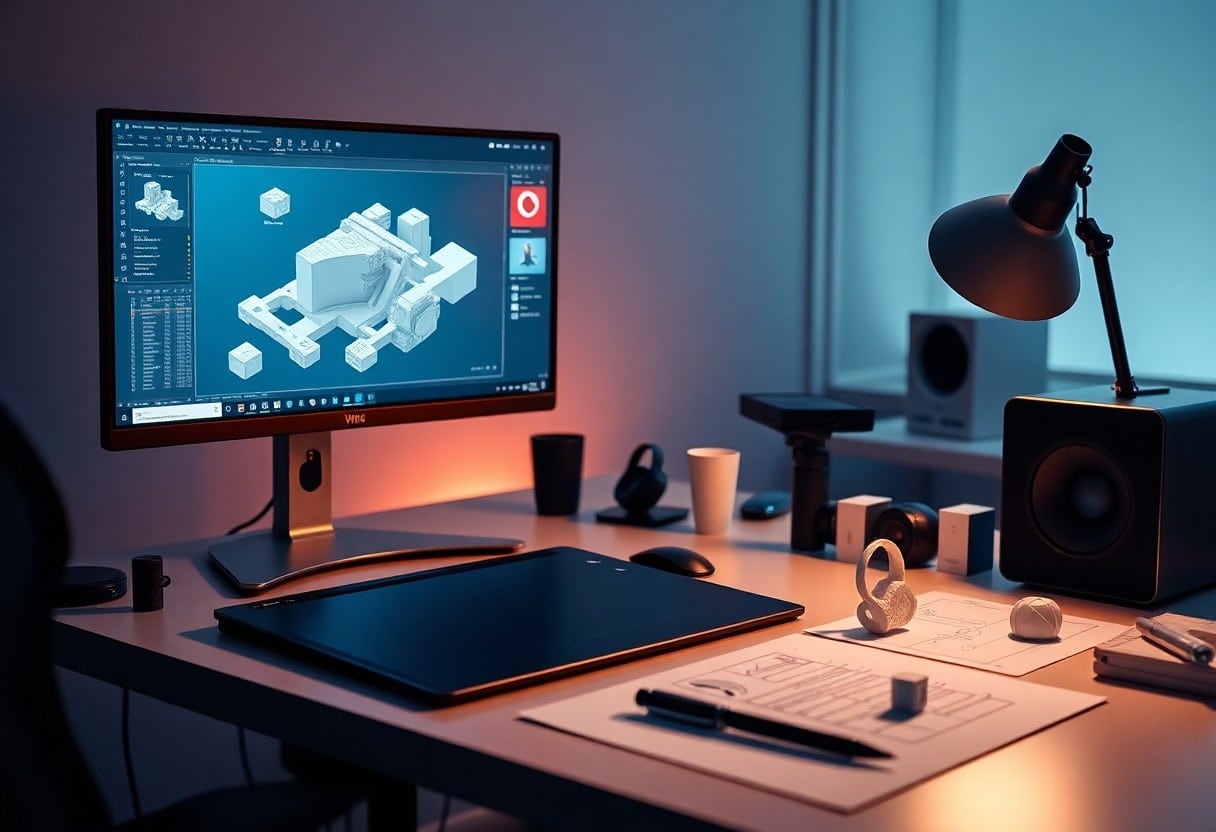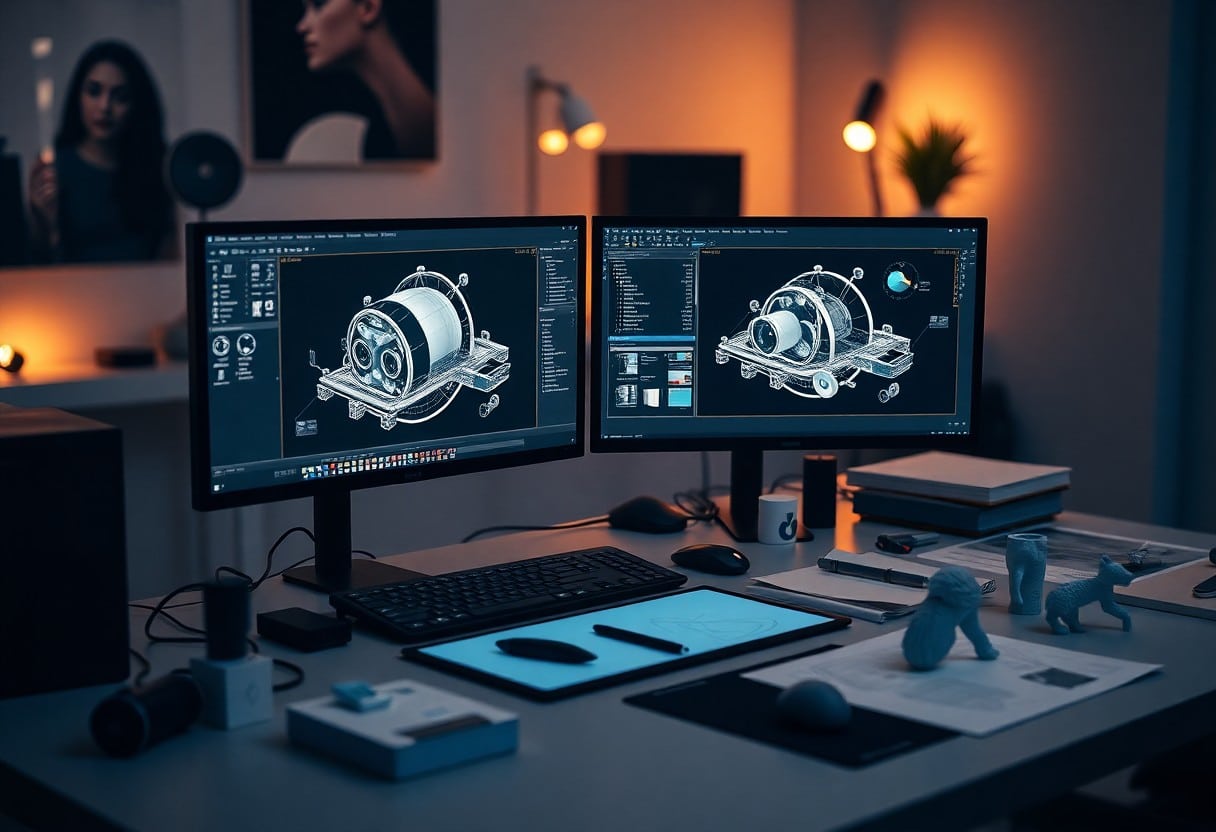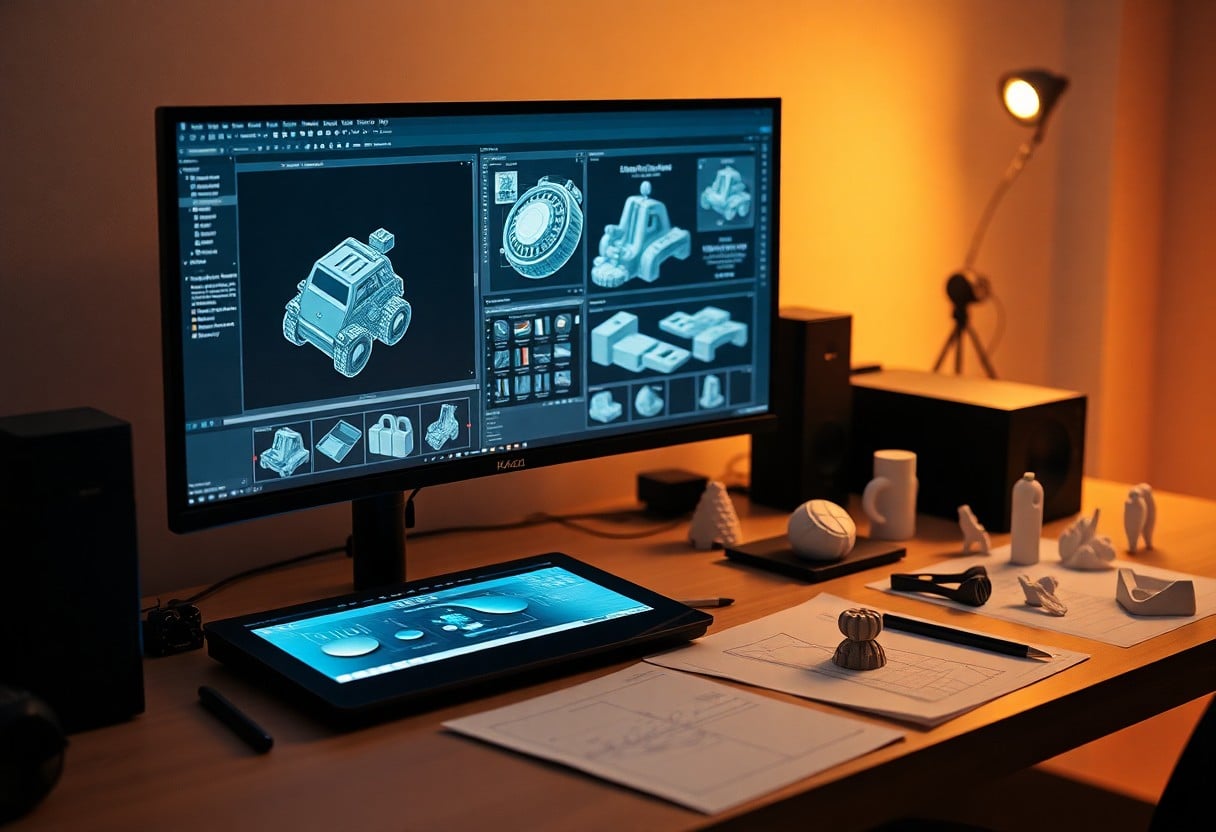Unleash Your Potential - 7 Steps to Complete Proficiency with 3D Modeling Software
In today's digital age, mastering 3D modeling software is an important skill for your design and creative work. BySeven Simple StepsYou will be able to achieveFully professional levelThis article is designed to help you to stand out in this highly competitive field and to effectively organize your learning process to avoid common pitfalls and unleash your creative potential. Whether you're a beginner or an experienced user, this article is designed to provide practical advice to help you stand out in this competitive field and effectively layout your learning process to avoid the common pitfalls ofThe Failure TrapThe
Key Excerpt:
- Understanding the Basics - Familiarize yourself with the basic interface and tools of 3D modeling software before you begin.
- Practice Skills - Conduct regular project exercises to enhance your modeling skills.
- Learning Resources - Utilize online courses, tutorials, and community resources to continually learn new skills.
- Practice Criticism - Share your work with others and receive constructive criticism for self-improvement.
- Design Thinking - Utilize design thinking methods to enhance creativity and problem solving skills.
- Diversity of applications - Try different types of projects to expand your skill set and portfolio.
- Staying Motivated - Set small goals and keep pursuing progress to stay motivated to learn.

Understanding 3D Modeling Software
In today's digital world, 3D modeling software is an important tool for creating visual content. Whether you are a game developer, animator, or industrial designer, mastering these tools will help you turn your ideas into reality. Understanding the features, uses, and advantages and disadvantages of different software will make you more comfortable in choosing the right modeling software.
Popular Software Overview
There are several popular 3D modeling software on the market, each with its own characteristics, suitable for users with different needs. From professional Autodesk Maya,Blender To the game designed for Unity respond in singing Unreal EngineYou need to choose the right tool for your job.
Key Features
When choosing 3D modeling software, there are some key features that you should consider to ensure that it meets your needs. These features include powerful interface operationadequate Plug-in Supportgood Community Supportand efficient rendering speedThe
- interface operation - Consumer friendly for efficiency.
- Plug-in Support - Scalability to meet specific needs.
- Community Support - Online tutorials and resources to help with learning and troubleshooting.
- rendering speed - Reduce waiting time and improve work efficiency.
Any choice should be based on your own needs and preferences to ensure that you maximize the benefits of the software.
Choosing the right 3D modeling software is important because features and ease of use vary greatly from one software to another. You need to consider the following features to ensure that you find the software that best meets your needs:
- Learning Curves - Is it easy to learn and suitable for beginners.
- compatibility - Ability to work with other tools and formats.
- (manufacturing, production etc) costs - Whether the budget is sufficient and whether there is a free version.
- Update Frequency - Regular updates ensure that the software functions are constantly improving.
Any choice is a long-term commitment and should be examined carefully to ensure satisfaction at some point in the future.
Step 1: Master the Basics
In the process of learning 3D modeling software, theMastering the BasicsThis is a vital first step. It's not just about understanding what the software does, it's about being able to use it flexibly, laying a solid foundation for future advanced learning. By exploring what each tool can do, you can apply them more effectively, increasing your modeling efficiency and creativity.
familiarize oneself with the interface
Familiarizing yourself with your software's interface is the first thing you need to do to start modeling. Each 3D modeling software has a different interface design, and you need to take the time to familiarize yourself with the distribution of toolbars, menus, and buttons. Understanding the Interface StructureIt helps you to be more fluid in your creative process and not waste time looking for features.
Learning Basic Tools
Learning basic modeling tools is critical to your success. These tools are the foundation for creating your 3D objects, for example:Move, Rotate and Zoom ToolsFamiliarize yourself with these tools. Familiarizing yourself with these tools will not only improve your operational efficiency, but also help you realize your design intent more accurately and avoid unnecessary losses caused by improper operation.
Further mastery of the basic tools, especially the tools for moving, rotating, zooming, mirroring, and copying, will give you the tools you need to create with ease. With these tools, you can easily adjust the size and position of objects and create complex structures. Enhancing your understanding of the basic tools will provide you with a good foundation for subsequent advanced techniques, ensuring that your creative process is more efficient and professional. Don't underestimate the importance of familiarizing yourself with the basics - they are the key to truly unlocking your modeling potential.

Step 2: Build Your First Model
As you enter the world of 3D modeling, theBuilding the first modelThis is an exciting milestone. Not only is it a time to learn the basics of the software, but it is also a time to get your creative juices flowing. At this stage, you will understand how to start from scratch and gradually realize the blueprint of your idea.
Conceptualize Your Design
Before you start modeling, theConceptual Designis a critical step. Think about the object you want to create, including its form, function, and use. Using sketches or reference images can help you express your ideas more intuitively and provide a clear direction to avoid getting lost in the modeling process.
Step-by-step modeling techniques
in progressStep-by-step modeling techniquesThere are some basic methods and techniques you need to master. Start with simple geometries and work your way up to complex shapes. In practice, using the Find tool and editing functions to adjust your model will help you become more familiar with the software.
| finesse | Description |
|---|---|
| Planning Before You Begin | Think through and design the model to be built. |
| Mastering Basic Functions | Familiarize yourself with the basic tools and functions of the software to help with subsequent operations. |
| Repeated practice | Simulate different models and learn various techniques. |
Step-by-step modeling skills are a core element of your foray into 3D modeling. You should focus on increasing your proficiency with tools and basic modeling techniques so that you can achieve the desired level of accuracy and detail in your models. Additionally, by documenting your modeling process and reflecting on it frequently so that you can continually improve, you can also ensure that each step of your process has the right characteristics. Value respond in singing efficienciesThe
| Common Challenges | Solutions |
|---|---|
| depletion of creativity | Refer to other artworks or have a brainstorming session. |
| Technical Barriers | Seek help through online tutorials or communities. |
| Lack of patience | Set small goals and accomplish them step by step. |

Step 3: Texture and Material
During the 3D modeling process, theTextures and MaterialsIt is the key element that gives life to the model. Mastering this technique will make your work more realistic and visually appealing. If you find that your work isn't getting the attention it deserves, check out theWhat are the basic drone controls every beginner should know?, enhance your skills and exposure.
Understanding UV Mapping
UV mapping is the process of applying 2D textures to 3D models. UnderstandingUV ExpansionThe concept allows you to better manage the arrangement of textures and ensure that you get the right color and detail on each side.
Application textures and materials
Applying textures and materials is one of the steps to enhance the realism of a model. In this process, choosing the right material attributes, such as roughness, gloss, and reflectivity, is crucial. These properties have a direct impact on the model's performance under different light conditions. Therefore, it is important toFine tuningThese parameters are used to achieve the desired visual effect.
When applying textures and materials, remember toDelicateThe selection and adjustment of the textures can give your model a more realistic look. Choose the right picture for the texture and make sure you understand the properties of each material. Use theTemplate DesignChecking how your materials perform in different environments can help you avoid common mistakes and improve the quality of your work.
Step 4: Lighting and Rendering
In 3D modeling, theilluminationandadd washes of ink or color to a drawing (Chinese painting)It is an important element to ensure that your work is effectively represented in the final presentation. By understanding different lighting techniques, you can enhance the quality and realism of your models. To master these techniques, check outDrone Permit Application - 9 Steps to Secure Legal Flight in the UKThis will help you to go further in this field.
Types of Lighting in 3D
- ambient light: Provides uniform base lighting.
- Point Light Source: Simulates the effect of a small light source such as a light bulb.
- Spotlight: Concentrated lighting that emphasizes a specific area.
- do sth. with one's back to the light: Illuminates from behind an object to create a shadow effect.
- global illumination: Simulates the reflection of light in the real world.
These types of lighting can help you improve the authenticity and appeal of your work.
| Lighting Type | Features |
| ambient light | Non-directional, providing basic lighting |
| Point Light Source | Light emanates from a point, forming a halo. |
| Spotlight | Adjustable range of focus and dispersion to create strong contrasts |
| do sth. with one's back to the light | Bringing a sense of mystery and depth of field, emphasizing the edges of the objects. |
Best Rendering Tips
with respect toadd washes of ink or color to a drawing (Chinese painting)Choosing the right technology is crucial. You should master the different renderers and understand their characteristics so that you can choose the most appropriate way to present your model. The use of global illumination and reflective techniques can dramatically improve the results, creating more depth and realism in the image. High-quality renderings not only show the details of the model, but also emphasize its aesthetic value.
When rendering, make sure you use the correct material settings and lighting layout, which will directly affect the final visual effect. In addition, post-processing and anti-aliasing techniques are key to improving rendering quality. These are the elements you must consider in your quest for excellence in your work.
Step 5: Animation Basics
LearningAnimation BasicsIt is an important part of mastering 3D modeling software. Animation not only adds life to your work, but also gives your audience a deeper experience. In this step, you can learn how to learn 3D modeling in real time with resources such asHow do you ensure a smooth airborne flight approval experience?
Animation Principles
understandingsAnimation Principlesis the key to bringing your animation to life. These principles include consistency in timing, behavior, and movement, and through these elements you can create fluid and natural movement. Remember, good animation isn't just about movement, it's also about emotional expression.
Create simple animations
In CreationSimple AnimationDuring the animation process, you should first focus on basic movements and add subtle variations. Through simple movements and transformations, you can quickly master the basics of animation and build a solid foundation for more complex animations.
When you startCreate simple animationsAdding motion or variation to an object is the first step. Start with basic movement, such as moving an object along a track, and gradually add rotation and scaling effects. Use the animation principles you've learned to carefully adjust the movement of each frame to ensure smoothness. In addition, maintain critical reflection on your animation, which will allow you to identify opportunities for improvement and enhance your skills.
Unlocking Potential - Seven Steps to Complete Proficiency in 3D Modeling Software
With these seven steps, you will be able to effectively increase your proficiency in 3D modeling software to produce more creative and professional work. Whether you're a beginner or a user looking to deepen your skills, these methods will help you build a solid foundation and realize your potential. Follow these tips, keep practicing and exploring new techniques, and you'll be well on your way to reaching new heights in your 3D modeling career.
Frequently Asked Questions (FAQ)
Q: What is the main purpose of this book?
A: This book is designed to help readers improve their overall proficiency in 3D modeling software through a seven-step process that allows users to realize their potential and create high-quality 3D models.
Q: Which 3D modeling software is best suited for the steps in this book?
A: This book is based on many mainstream 3D modeling software, such as Blender, Maya, 3ds Max, etc. It is suitable for users of all experience levels. The techniques and steps in this book can be applied to most 3D modeling software.
Q: Who is this book for?
A: This book is suitable for beginners to experienced 3D modeling enthusiasts, especially those who wish to upgrade their skills or enter the 3D modeling industry.
Q: What prerequisite knowledge do I need to read this book?
A: Readers do not need to have any professional background, just an interest in 3D modeling and basic computer skills. Some basic drawing skills would be helpful, but not necessary.
Q: How will this book help me achieve total mastery?
A: This book provides a series of step-by-step procedures, including theoretical knowledge, practical operations, and case studies, to help readers systematically master various techniques and processes of 3D modeling.
Q: Is this book a physical book or an e-book?
A: This book is available in both physical book and e-book formats, so readers can choose according to their own preferences, whether it is a portable e-book or a traditional physical book to meet the needs.
Q: Are there any online resources to supplement the learning in the book?
A: Yes, the book provides additional online resources, including video tutorials, example model downloads, and community forums to help readers gain a deeper understanding of the book and communicate their learning progress in real time.




